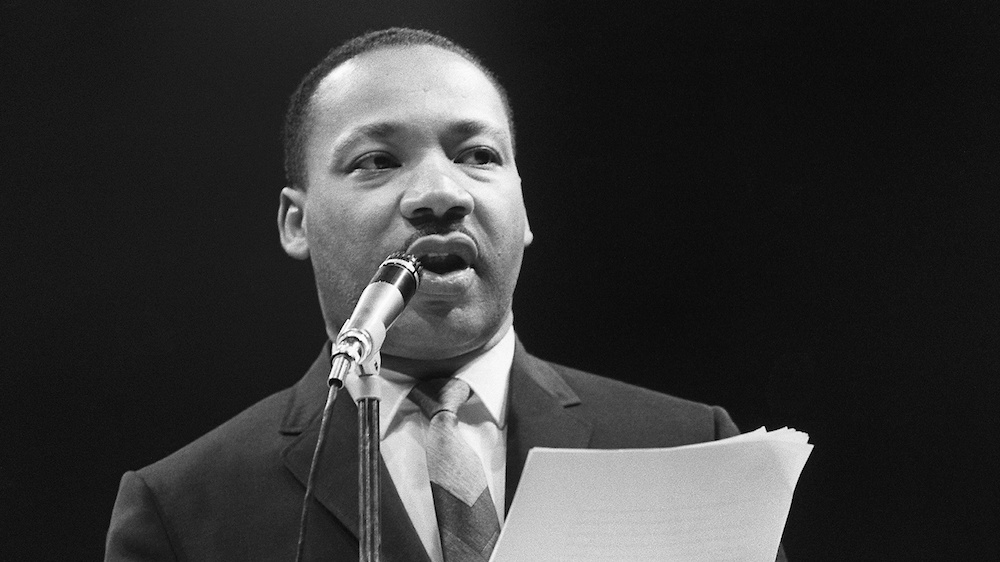If you’re interested in sharing your opinion on any cultural, political or personal topic, create an account here and check out our how-to post to learn more.
Opinions are the writer’s own and not those of Blavity's.
____
Can you kill the dream by killing the dreamer?
This was the question on many Americans' lips 53 years ago, on April 4, 1968. That was the day a bullet from a white supremacist's gun caught up with Martin Luther King Jr. on a balcony in my hometown of Memphis, Tennessee.
The 14 years prior to that fateful day — between 1954 and 1968 — had seen incredible movement from an era of Jim Crow, which had been frozen in place since the end of the Civil War. Brown vs. the Board of Education, despite its failure to end racial segregation in schools, began the attempt at turning that tide. That decision was followed by the Montgomery bus boycott, sit-ins at lunch counters across the south, the integration of public accommodations, the Civil Rights Act, the Voting Rights Act and the Fair Housing Act, signed by LBJ 1 week after King was assassinated. Despite that progress, it wasn't long before Dr. King's dream encountered a new set of roadblocks based on white supremacy and racism. Just a few years later, President Nixon announced a forthcoming war on drugs.
I was 11 years old when King was assassinated, and I can remember people saying, "You can kill the dreamer, but you can't kill the dream." The evidence of America's progress toward racial justice over the last 53 years has brought that statement into question. In 2018, the Economic Policy Institute released a report showing that since 1968 no progress had been made in closing the gap between whites and African Americans when it comes to homeownership, unemployment and incarceration.
Several years ago, the Institute for Policy Studies and the Corporation for Enterprise Development examined America's racial wealth gap. They found that not only was that gap growing but that over the past 30 years, the average wealth of white families had grown by more than three times the rate of Black families. That report concluded that by 2043 when people of color will likely make up a majority of the American population, the wealth gap between white families and Black families will have doubled again. If these trends continue, it will take Black Americans 228 years to amass the same amount of wealth that white families have today.
Looking at these studies combined with current events might cause one to conclude that if the dream isn't dead, it is on life support. In Dr. King's home state of Georgia, we recently saw images of white men in front of a plantation painting, signing a racially restrictive voting rights act in a locked room. At the same time, a Black woman was arrested outside for knocking on the door. On September 23, 1955, an all–white jury acquitted two men named Bryant and Milam, who were accused of the murder of Emmett Till. 65 years later – on September 23, 2020 – it was announced that two Louisville police officers would face no charges over the murder of Breonna Taylor. And, of course, we all saw the events of January 6 at our capital. I promise you, the people that stormed the Capitol want to take America back to a place that has no room for racial justice.
Despite the grim state of racial injustice during his time, the poet Langston Hughes admonished us to "Hold fast to dreams, for if dreams die Life is a broken-winged bird that cannot fly." The work of Stacy Abram and other Black people in the south is a testament to that hope and is a significant reason that we have a Biden administration as opposed to a second Trump administration.
The protests occurring across America, which have brought the issue of racial justice to the forefront, have been more diverse than any demonstrations in American history. That dream is alive in Congress, where HR 1 aims to ensure voting rights, and HR 40, the bill for reparations for slavery, has more than 170 cosponsors. On the local level, reparations efforts, like the one in Evanston, Illinois, demonstrate that America may finally be ready to reckon with our history of white supremacy and racism.
It is evident to most that America is at a tipping point on racial justice. We have been here before but consistently found ways to take two steps backward. Instead of rejecting the institution of slavery during the constitutional convention, we doubled down on it. Instead of continuing Reconstruction after the Civil War, we reversed course with Black codes, Jim Crow, and separate but equal. And in 1968, when a bullet killed a man with a dream on a balcony in Memphis, we stepped right into the war on drugs and mass incarceration. This tipping point may be our last, best chance to get it right.
The dream has survived after the slaying of the dreamer, but continued progress toward the dream is on our generation's shoulders. Amanda Gorman made it clear to all of us when she said, "We know inaction and inertia become the inheritance of the next generation. Our blunders are their burdens."
While the dreamer has been dead for more than half a century, we must fight to keep his dream alive. It is no longer about who he was, but about who we are and who we want to be as a nation.

